Managing Operations and Projects
VerifiedAdded on 2022/12/28
|15
|3406
|27
AI Summary
This document provides insights into managing operations and projects. It covers topics such as scope management plan, time management plan, cost management plan, and communication management plan. The content includes project objectives, project scope, assumptions, constraints, project milestones, project network diagram, cost breakdown and budget, and project stakeholders.
Contribute Materials
Your contribution can guide someone’s learning journey. Share your
documents today.
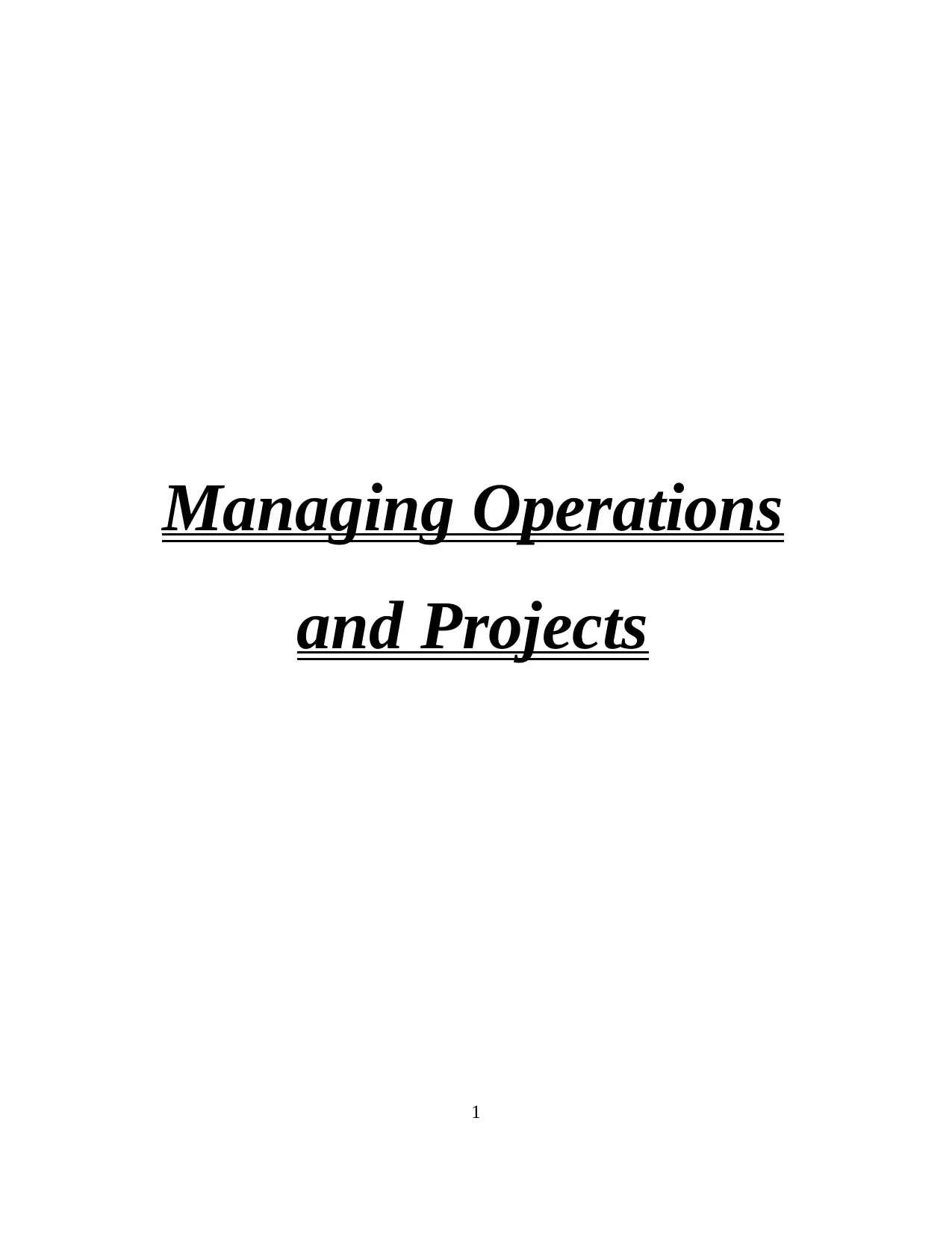
Managing Operations
and Projects
1
and Projects
1
Secure Best Marks with AI Grader
Need help grading? Try our AI Grader for instant feedback on your assignments.
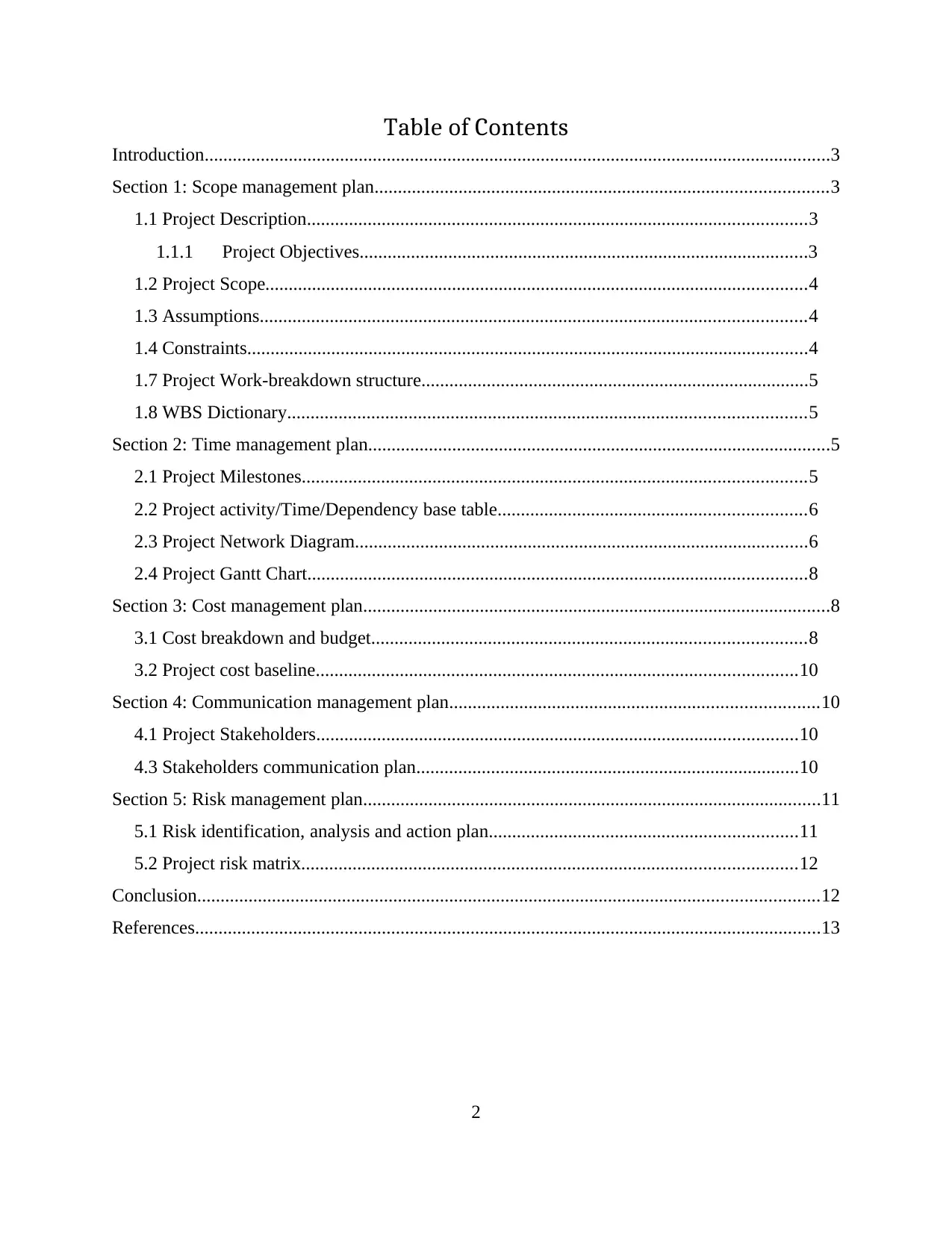
Table of Contents
Introduction......................................................................................................................................3
Section 1: Scope management plan.................................................................................................3
1.1 Project Description...........................................................................................................3
1.1.1 Project Objectives................................................................................................3
1.2 Project Scope....................................................................................................................4
1.3 Assumptions.....................................................................................................................4
1.4 Constraints........................................................................................................................4
1.7 Project Work-breakdown structure...................................................................................5
1.8 WBS Dictionary...............................................................................................................5
Section 2: Time management plan...................................................................................................5
2.1 Project Milestones............................................................................................................5
2.2 Project activity/Time/Dependency base table..................................................................6
2.3 Project Network Diagram.................................................................................................6
2.4 Project Gantt Chart...........................................................................................................8
Section 3: Cost management plan....................................................................................................8
3.1 Cost breakdown and budget.............................................................................................8
3.2 Project cost baseline.......................................................................................................10
Section 4: Communication management plan...............................................................................10
4.1 Project Stakeholders.......................................................................................................10
4.3 Stakeholders communication plan..................................................................................10
Section 5: Risk management plan..................................................................................................11
5.1 Risk identification, analysis and action plan..................................................................11
5.2 Project risk matrix..........................................................................................................12
Conclusion.....................................................................................................................................12
References......................................................................................................................................13
2
Introduction......................................................................................................................................3
Section 1: Scope management plan.................................................................................................3
1.1 Project Description...........................................................................................................3
1.1.1 Project Objectives................................................................................................3
1.2 Project Scope....................................................................................................................4
1.3 Assumptions.....................................................................................................................4
1.4 Constraints........................................................................................................................4
1.7 Project Work-breakdown structure...................................................................................5
1.8 WBS Dictionary...............................................................................................................5
Section 2: Time management plan...................................................................................................5
2.1 Project Milestones............................................................................................................5
2.2 Project activity/Time/Dependency base table..................................................................6
2.3 Project Network Diagram.................................................................................................6
2.4 Project Gantt Chart...........................................................................................................8
Section 3: Cost management plan....................................................................................................8
3.1 Cost breakdown and budget.............................................................................................8
3.2 Project cost baseline.......................................................................................................10
Section 4: Communication management plan...............................................................................10
4.1 Project Stakeholders.......................................................................................................10
4.3 Stakeholders communication plan..................................................................................10
Section 5: Risk management plan..................................................................................................11
5.1 Risk identification, analysis and action plan..................................................................11
5.2 Project risk matrix..........................................................................................................12
Conclusion.....................................................................................................................................12
References......................................................................................................................................13
2
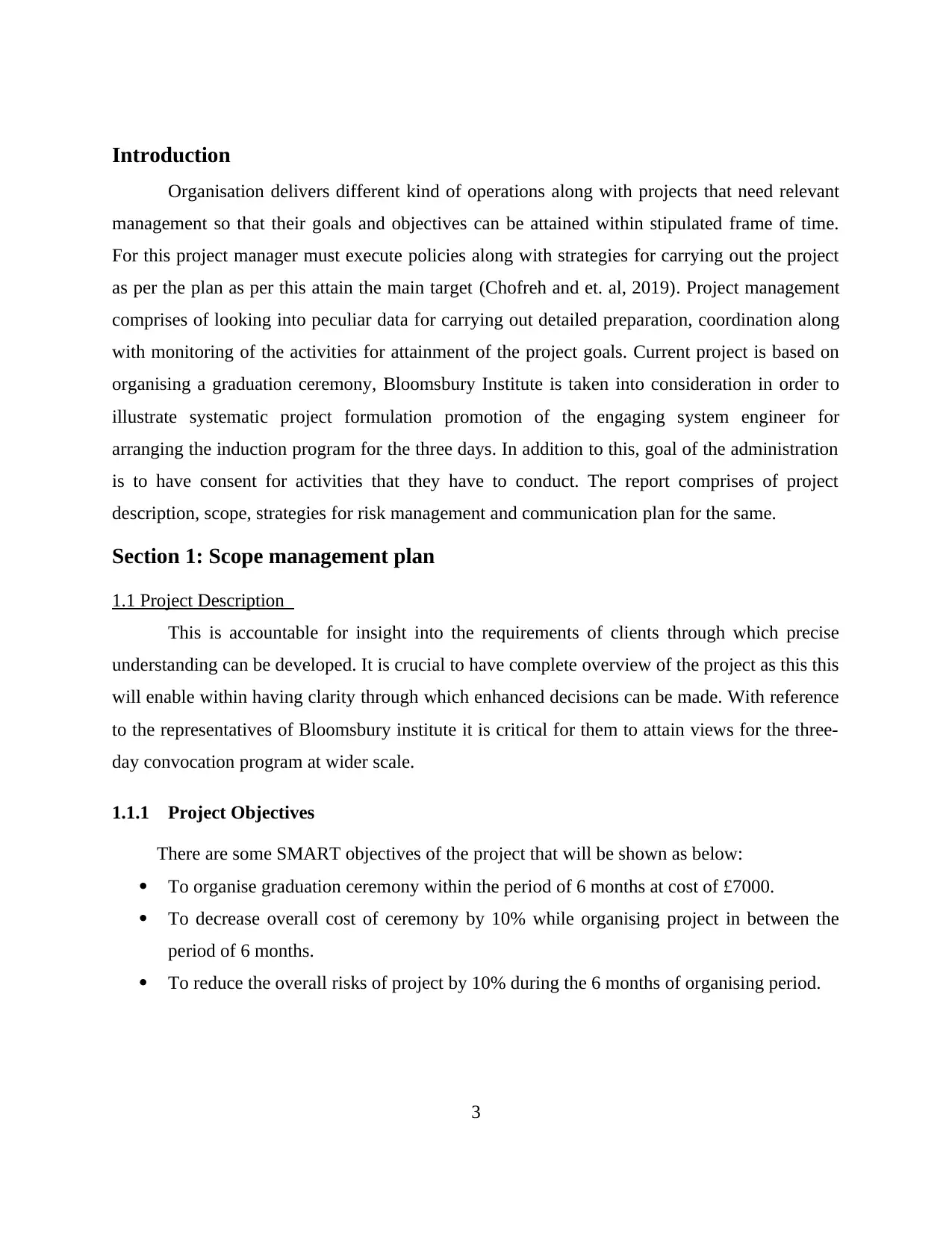
Introduction
Organisation delivers different kind of operations along with projects that need relevant
management so that their goals and objectives can be attained within stipulated frame of time.
For this project manager must execute policies along with strategies for carrying out the project
as per the plan as per this attain the main target (Chofreh and et. al, 2019). Project management
comprises of looking into peculiar data for carrying out detailed preparation, coordination along
with monitoring of the activities for attainment of the project goals. Current project is based on
organising a graduation ceremony, Bloomsbury Institute is taken into consideration in order to
illustrate systematic project formulation promotion of the engaging system engineer for
arranging the induction program for the three days. In addition to this, goal of the administration
is to have consent for activities that they have to conduct. The report comprises of project
description, scope, strategies for risk management and communication plan for the same.
Section 1: Scope management plan
1.1 Project Description
This is accountable for insight into the requirements of clients through which precise
understanding can be developed. It is crucial to have complete overview of the project as this this
will enable within having clarity through which enhanced decisions can be made. With reference
to the representatives of Bloomsbury institute it is critical for them to attain views for the three-
day convocation program at wider scale.
1.1.1 Project Objectives
There are some SMART objectives of the project that will be shown as below:
To organise graduation ceremony within the period of 6 months at cost of £7000.
To decrease overall cost of ceremony by 10% while organising project in between the
period of 6 months.
To reduce the overall risks of project by 10% during the 6 months of organising period.
3
Organisation delivers different kind of operations along with projects that need relevant
management so that their goals and objectives can be attained within stipulated frame of time.
For this project manager must execute policies along with strategies for carrying out the project
as per the plan as per this attain the main target (Chofreh and et. al, 2019). Project management
comprises of looking into peculiar data for carrying out detailed preparation, coordination along
with monitoring of the activities for attainment of the project goals. Current project is based on
organising a graduation ceremony, Bloomsbury Institute is taken into consideration in order to
illustrate systematic project formulation promotion of the engaging system engineer for
arranging the induction program for the three days. In addition to this, goal of the administration
is to have consent for activities that they have to conduct. The report comprises of project
description, scope, strategies for risk management and communication plan for the same.
Section 1: Scope management plan
1.1 Project Description
This is accountable for insight into the requirements of clients through which precise
understanding can be developed. It is crucial to have complete overview of the project as this this
will enable within having clarity through which enhanced decisions can be made. With reference
to the representatives of Bloomsbury institute it is critical for them to attain views for the three-
day convocation program at wider scale.
1.1.1 Project Objectives
There are some SMART objectives of the project that will be shown as below:
To organise graduation ceremony within the period of 6 months at cost of £7000.
To decrease overall cost of ceremony by 10% while organising project in between the
period of 6 months.
To reduce the overall risks of project by 10% during the 6 months of organising period.
3
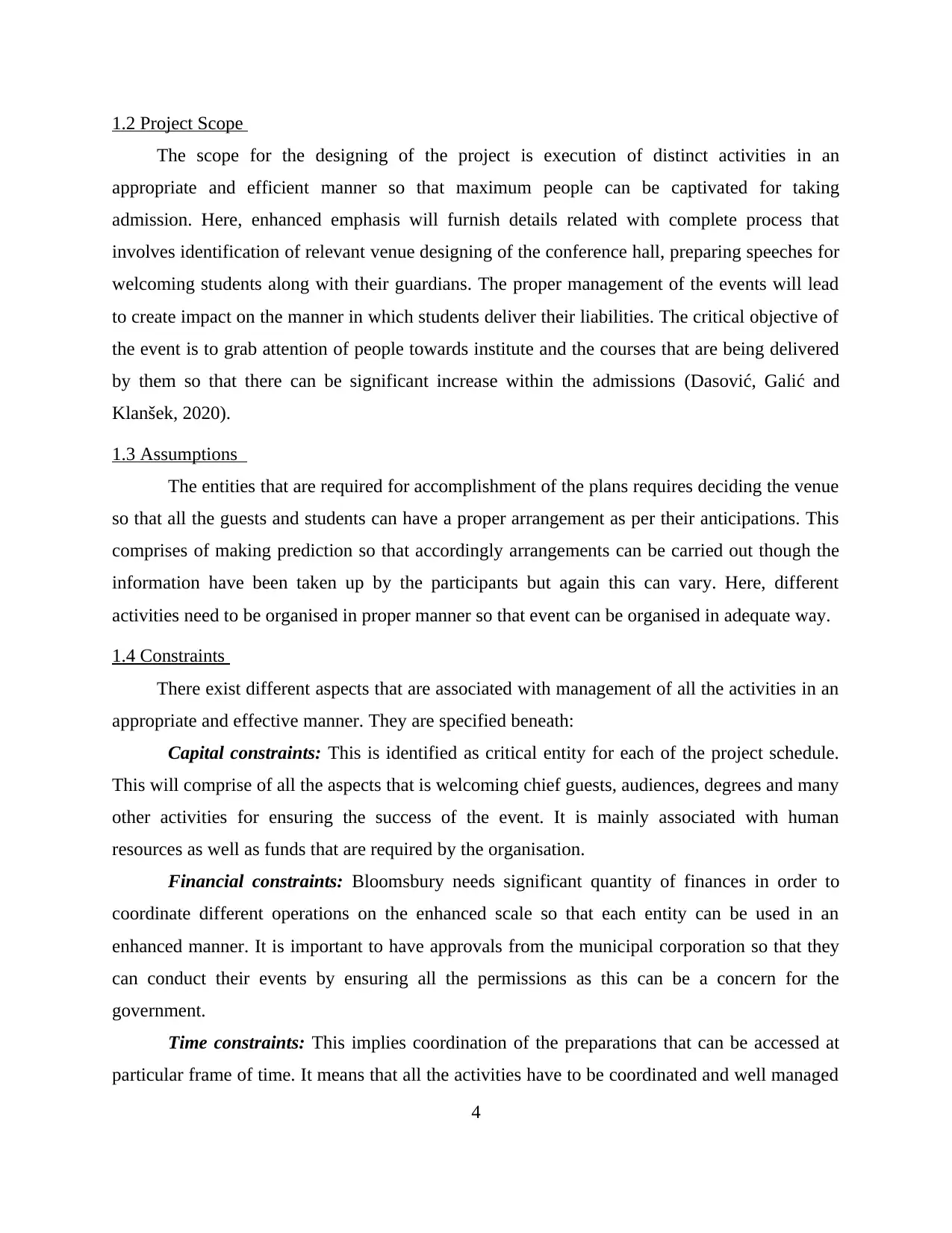
1.2 Project Scope
The scope for the designing of the project is execution of distinct activities in an
appropriate and efficient manner so that maximum people can be captivated for taking
admission. Here, enhanced emphasis will furnish details related with complete process that
involves identification of relevant venue designing of the conference hall, preparing speeches for
welcoming students along with their guardians. The proper management of the events will lead
to create impact on the manner in which students deliver their liabilities. The critical objective of
the event is to grab attention of people towards institute and the courses that are being delivered
by them so that there can be significant increase within the admissions (Dasović, Galić and
Klanšek, 2020).
1.3 Assumptions
The entities that are required for accomplishment of the plans requires deciding the venue
so that all the guests and students can have a proper arrangement as per their anticipations. This
comprises of making prediction so that accordingly arrangements can be carried out though the
information have been taken up by the participants but again this can vary. Here, different
activities need to be organised in proper manner so that event can be organised in adequate way.
1.4 Constraints
There exist different aspects that are associated with management of all the activities in an
appropriate and effective manner. They are specified beneath:
Capital constraints: This is identified as critical entity for each of the project schedule.
This will comprise of all the aspects that is welcoming chief guests, audiences, degrees and many
other activities for ensuring the success of the event. It is mainly associated with human
resources as well as funds that are required by the organisation.
Financial constraints: Bloomsbury needs significant quantity of finances in order to
coordinate different operations on the enhanced scale so that each entity can be used in an
enhanced manner. It is important to have approvals from the municipal corporation so that they
can conduct their events by ensuring all the permissions as this can be a concern for the
government.
Time constraints: This implies coordination of the preparations that can be accessed at
particular frame of time. It means that all the activities have to be coordinated and well managed
4
The scope for the designing of the project is execution of distinct activities in an
appropriate and efficient manner so that maximum people can be captivated for taking
admission. Here, enhanced emphasis will furnish details related with complete process that
involves identification of relevant venue designing of the conference hall, preparing speeches for
welcoming students along with their guardians. The proper management of the events will lead
to create impact on the manner in which students deliver their liabilities. The critical objective of
the event is to grab attention of people towards institute and the courses that are being delivered
by them so that there can be significant increase within the admissions (Dasović, Galić and
Klanšek, 2020).
1.3 Assumptions
The entities that are required for accomplishment of the plans requires deciding the venue
so that all the guests and students can have a proper arrangement as per their anticipations. This
comprises of making prediction so that accordingly arrangements can be carried out though the
information have been taken up by the participants but again this can vary. Here, different
activities need to be organised in proper manner so that event can be organised in adequate way.
1.4 Constraints
There exist different aspects that are associated with management of all the activities in an
appropriate and effective manner. They are specified beneath:
Capital constraints: This is identified as critical entity for each of the project schedule.
This will comprise of all the aspects that is welcoming chief guests, audiences, degrees and many
other activities for ensuring the success of the event. It is mainly associated with human
resources as well as funds that are required by the organisation.
Financial constraints: Bloomsbury needs significant quantity of finances in order to
coordinate different operations on the enhanced scale so that each entity can be used in an
enhanced manner. It is important to have approvals from the municipal corporation so that they
can conduct their events by ensuring all the permissions as this can be a concern for the
government.
Time constraints: This implies coordination of the preparations that can be accessed at
particular frame of time. It means that all the activities have to be coordinated and well managed
4
Secure Best Marks with AI Grader
Need help grading? Try our AI Grader for instant feedback on your assignments.
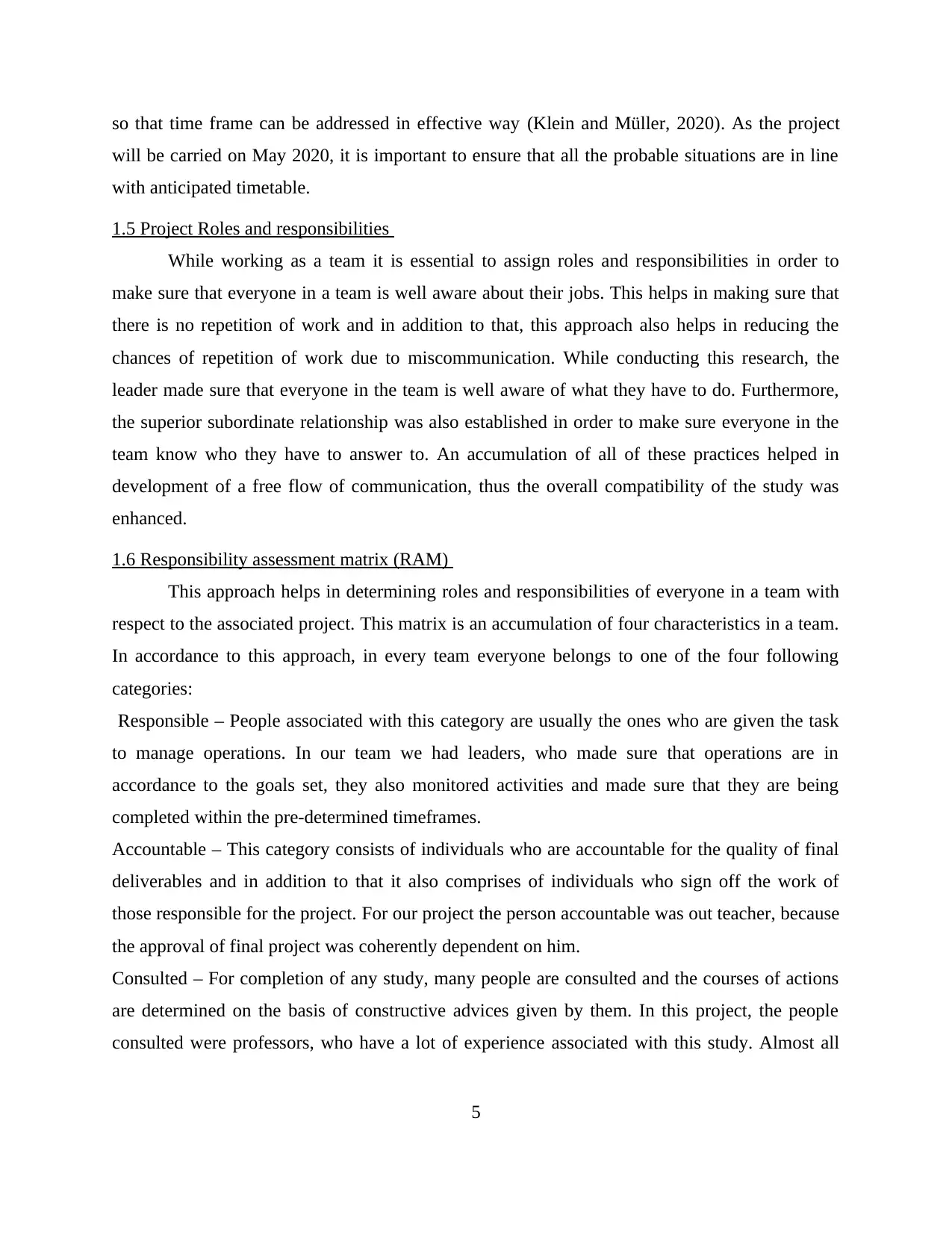
so that time frame can be addressed in effective way (Klein and Müller, 2020). As the project
will be carried on May 2020, it is important to ensure that all the probable situations are in line
with anticipated timetable.
1.5 Project Roles and responsibilities
While working as a team it is essential to assign roles and responsibilities in order to
make sure that everyone in a team is well aware about their jobs. This helps in making sure that
there is no repetition of work and in addition to that, this approach also helps in reducing the
chances of repetition of work due to miscommunication. While conducting this research, the
leader made sure that everyone in the team is well aware of what they have to do. Furthermore,
the superior subordinate relationship was also established in order to make sure everyone in the
team know who they have to answer to. An accumulation of all of these practices helped in
development of a free flow of communication, thus the overall compatibility of the study was
enhanced.
1.6 Responsibility assessment matrix (RAM)
This approach helps in determining roles and responsibilities of everyone in a team with
respect to the associated project. This matrix is an accumulation of four characteristics in a team.
In accordance to this approach, in every team everyone belongs to one of the four following
categories:
Responsible – People associated with this category are usually the ones who are given the task
to manage operations. In our team we had leaders, who made sure that operations are in
accordance to the goals set, they also monitored activities and made sure that they are being
completed within the pre-determined timeframes.
Accountable – This category consists of individuals who are accountable for the quality of final
deliverables and in addition to that it also comprises of individuals who sign off the work of
those responsible for the project. For our project the person accountable was out teacher, because
the approval of final project was coherently dependent on him.
Consulted – For completion of any study, many people are consulted and the courses of actions
are determined on the basis of constructive advices given by them. In this project, the people
consulted were professors, who have a lot of experience associated with this study. Almost all
5
will be carried on May 2020, it is important to ensure that all the probable situations are in line
with anticipated timetable.
1.5 Project Roles and responsibilities
While working as a team it is essential to assign roles and responsibilities in order to
make sure that everyone in a team is well aware about their jobs. This helps in making sure that
there is no repetition of work and in addition to that, this approach also helps in reducing the
chances of repetition of work due to miscommunication. While conducting this research, the
leader made sure that everyone in the team is well aware of what they have to do. Furthermore,
the superior subordinate relationship was also established in order to make sure everyone in the
team know who they have to answer to. An accumulation of all of these practices helped in
development of a free flow of communication, thus the overall compatibility of the study was
enhanced.
1.6 Responsibility assessment matrix (RAM)
This approach helps in determining roles and responsibilities of everyone in a team with
respect to the associated project. This matrix is an accumulation of four characteristics in a team.
In accordance to this approach, in every team everyone belongs to one of the four following
categories:
Responsible – People associated with this category are usually the ones who are given the task
to manage operations. In our team we had leaders, who made sure that operations are in
accordance to the goals set, they also monitored activities and made sure that they are being
completed within the pre-determined timeframes.
Accountable – This category consists of individuals who are accountable for the quality of final
deliverables and in addition to that it also comprises of individuals who sign off the work of
those responsible for the project. For our project the person accountable was out teacher, because
the approval of final project was coherently dependent on him.
Consulted – For completion of any study, many people are consulted and the courses of actions
are determined on the basis of constructive advices given by them. In this project, the people
consulted were professors, who have a lot of experience associated with this study. Almost all
5
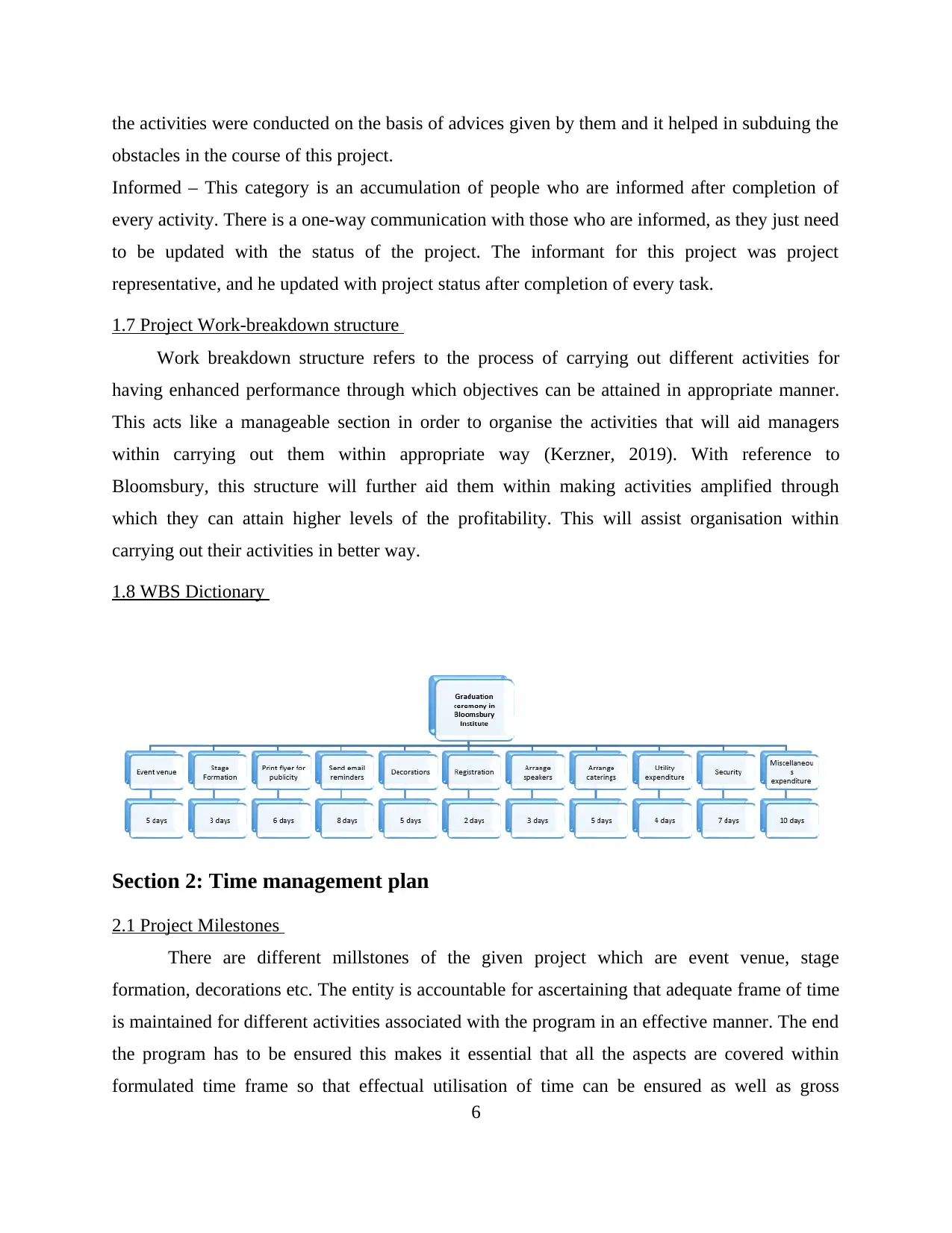
the activities were conducted on the basis of advices given by them and it helped in subduing the
obstacles in the course of this project.
Informed – This category is an accumulation of people who are informed after completion of
every activity. There is a one-way communication with those who are informed, as they just need
to be updated with the status of the project. The informant for this project was project
representative, and he updated with project status after completion of every task.
1.7 Project Work-breakdown structure
Work breakdown structure refers to the process of carrying out different activities for
having enhanced performance through which objectives can be attained in appropriate manner.
This acts like a manageable section in order to organise the activities that will aid managers
within carrying out them within appropriate way (Kerzner, 2019). With reference to
Bloomsbury, this structure will further aid them within making activities amplified through
which they can attain higher levels of the profitability. This will assist organisation within
carrying out their activities in better way.
1.8 WBS Dictionary
Section 2: Time management plan
2.1 Project Milestones
There are different millstones of the given project which are event venue, stage
formation, decorations etc. The entity is accountable for ascertaining that adequate frame of time
is maintained for different activities associated with the program in an effective manner. The end
the program has to be ensured this makes it essential that all the aspects are covered within
formulated time frame so that effectual utilisation of time can be ensured as well as gross
6
obstacles in the course of this project.
Informed – This category is an accumulation of people who are informed after completion of
every activity. There is a one-way communication with those who are informed, as they just need
to be updated with the status of the project. The informant for this project was project
representative, and he updated with project status after completion of every task.
1.7 Project Work-breakdown structure
Work breakdown structure refers to the process of carrying out different activities for
having enhanced performance through which objectives can be attained in appropriate manner.
This acts like a manageable section in order to organise the activities that will aid managers
within carrying out them within appropriate way (Kerzner, 2019). With reference to
Bloomsbury, this structure will further aid them within making activities amplified through
which they can attain higher levels of the profitability. This will assist organisation within
carrying out their activities in better way.
1.8 WBS Dictionary
Section 2: Time management plan
2.1 Project Milestones
There are different millstones of the given project which are event venue, stage
formation, decorations etc. The entity is accountable for ascertaining that adequate frame of time
is maintained for different activities associated with the program in an effective manner. The end
the program has to be ensured this makes it essential that all the aspects are covered within
formulated time frame so that effectual utilisation of time can be ensured as well as gross
6
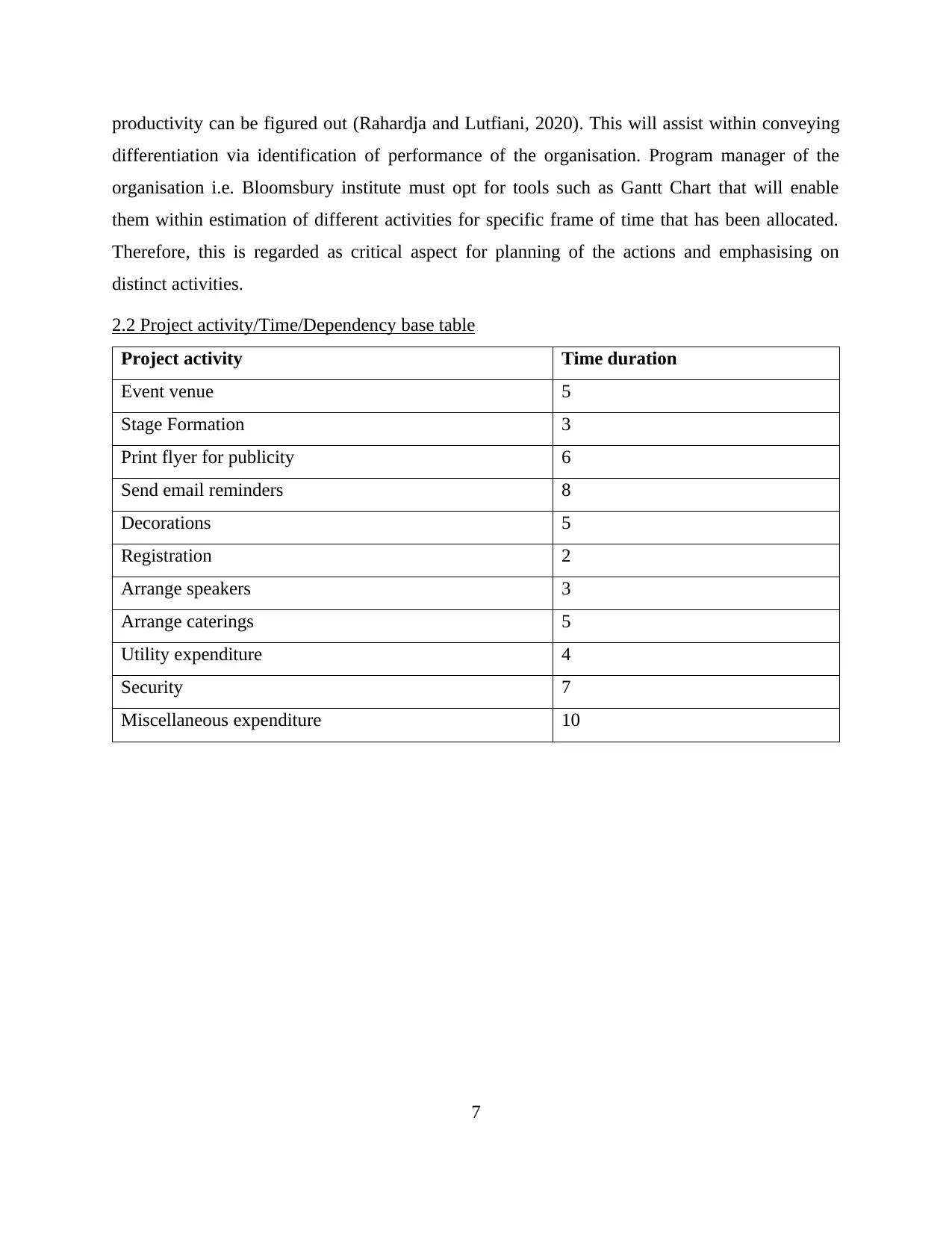
productivity can be figured out (Rahardja and Lutfiani, 2020). This will assist within conveying
differentiation via identification of performance of the organisation. Program manager of the
organisation i.e. Bloomsbury institute must opt for tools such as Gantt Chart that will enable
them within estimation of different activities for specific frame of time that has been allocated.
Therefore, this is regarded as critical aspect for planning of the actions and emphasising on
distinct activities.
2.2 Project activity/Time/Dependency base table
Project activity Time duration
Event venue 5
Stage Formation 3
Print flyer for publicity 6
Send email reminders 8
Decorations 5
Registration 2
Arrange speakers 3
Arrange caterings 5
Utility expenditure 4
Security 7
Miscellaneous expenditure 10
7
differentiation via identification of performance of the organisation. Program manager of the
organisation i.e. Bloomsbury institute must opt for tools such as Gantt Chart that will enable
them within estimation of different activities for specific frame of time that has been allocated.
Therefore, this is regarded as critical aspect for planning of the actions and emphasising on
distinct activities.
2.2 Project activity/Time/Dependency base table
Project activity Time duration
Event venue 5
Stage Formation 3
Print flyer for publicity 6
Send email reminders 8
Decorations 5
Registration 2
Arrange speakers 3
Arrange caterings 5
Utility expenditure 4
Security 7
Miscellaneous expenditure 10
7
Paraphrase This Document
Need a fresh take? Get an instant paraphrase of this document with our AI Paraphraser
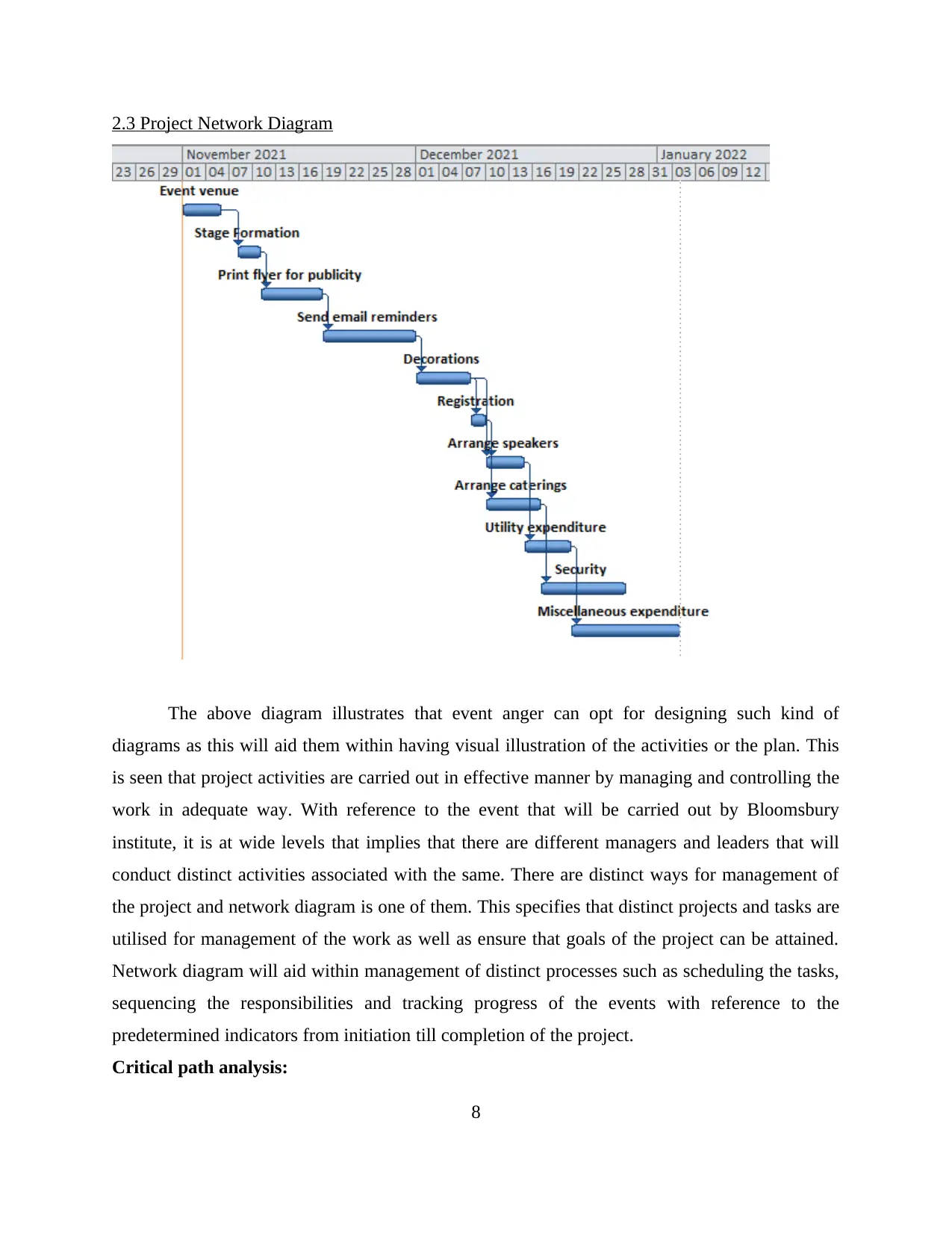
2.3 Project Network Diagram
The above diagram illustrates that event anger can opt for designing such kind of
diagrams as this will aid them within having visual illustration of the activities or the plan. This
is seen that project activities are carried out in effective manner by managing and controlling the
work in adequate way. With reference to the event that will be carried out by Bloomsbury
institute, it is at wide levels that implies that there are different managers and leaders that will
conduct distinct activities associated with the same. There are distinct ways for management of
the project and network diagram is one of them. This specifies that distinct projects and tasks are
utilised for management of the work as well as ensure that goals of the project can be attained.
Network diagram will aid within management of distinct processes such as scheduling the tasks,
sequencing the responsibilities and tracking progress of the events with reference to the
predetermined indicators from initiation till completion of the project.
Critical path analysis:
8
The above diagram illustrates that event anger can opt for designing such kind of
diagrams as this will aid them within having visual illustration of the activities or the plan. This
is seen that project activities are carried out in effective manner by managing and controlling the
work in adequate way. With reference to the event that will be carried out by Bloomsbury
institute, it is at wide levels that implies that there are different managers and leaders that will
conduct distinct activities associated with the same. There are distinct ways for management of
the project and network diagram is one of them. This specifies that distinct projects and tasks are
utilised for management of the work as well as ensure that goals of the project can be attained.
Network diagram will aid within management of distinct processes such as scheduling the tasks,
sequencing the responsibilities and tracking progress of the events with reference to the
predetermined indicators from initiation till completion of the project.
Critical path analysis:
8
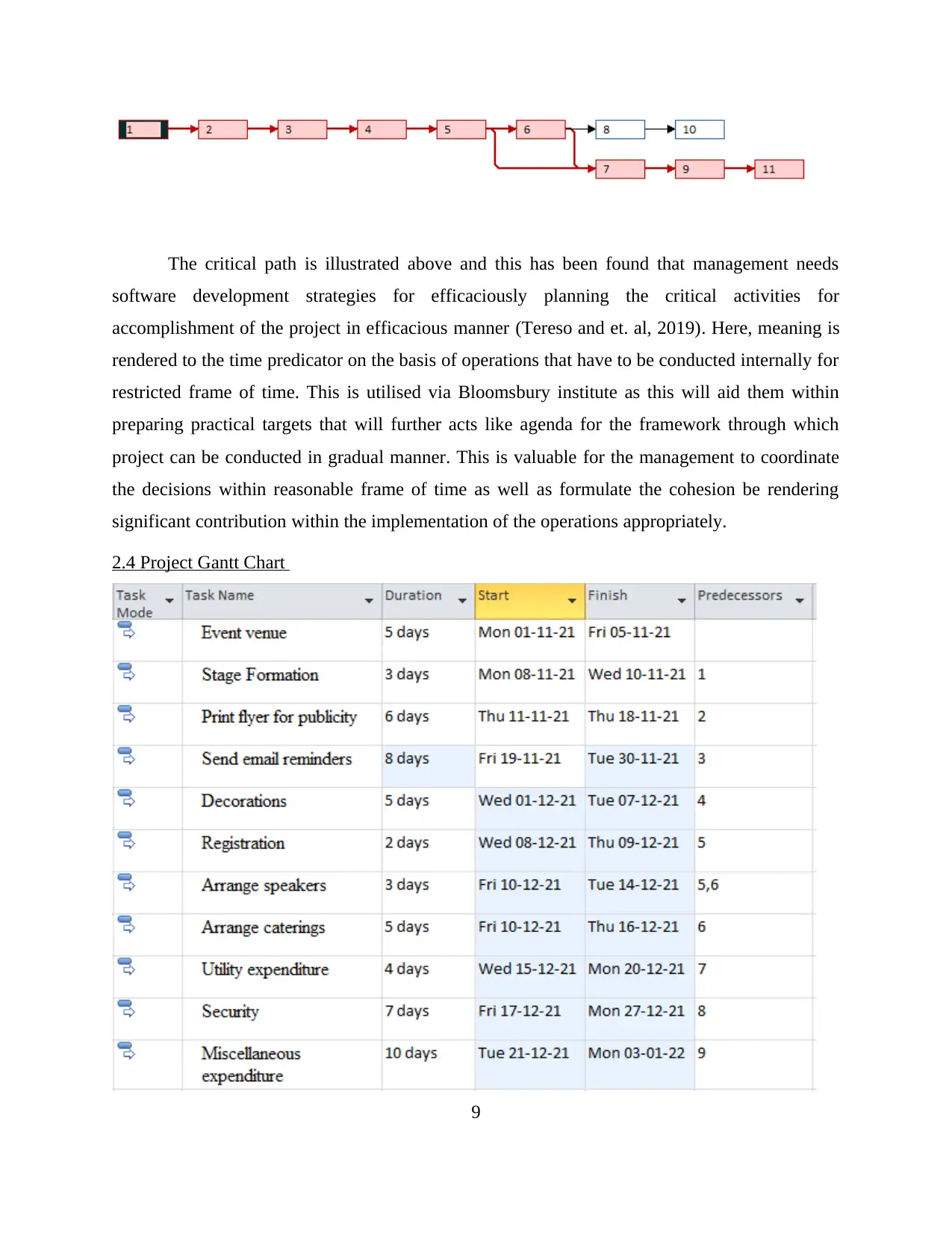
The critical path is illustrated above and this has been found that management needs
software development strategies for efficaciously planning the critical activities for
accomplishment of the project in efficacious manner (Tereso and et. al, 2019). Here, meaning is
rendered to the time predicator on the basis of operations that have to be conducted internally for
restricted frame of time. This is utilised via Bloomsbury institute as this will aid them within
preparing practical targets that will further acts like agenda for the framework through which
project can be conducted in gradual manner. This is valuable for the management to coordinate
the decisions within reasonable frame of time as well as formulate the cohesion be rendering
significant contribution within the implementation of the operations appropriately.
2.4 Project Gantt Chart
9
software development strategies for efficaciously planning the critical activities for
accomplishment of the project in efficacious manner (Tereso and et. al, 2019). Here, meaning is
rendered to the time predicator on the basis of operations that have to be conducted internally for
restricted frame of time. This is utilised via Bloomsbury institute as this will aid them within
preparing practical targets that will further acts like agenda for the framework through which
project can be conducted in gradual manner. This is valuable for the management to coordinate
the decisions within reasonable frame of time as well as formulate the cohesion be rendering
significant contribution within the implementation of the operations appropriately.
2.4 Project Gantt Chart
9
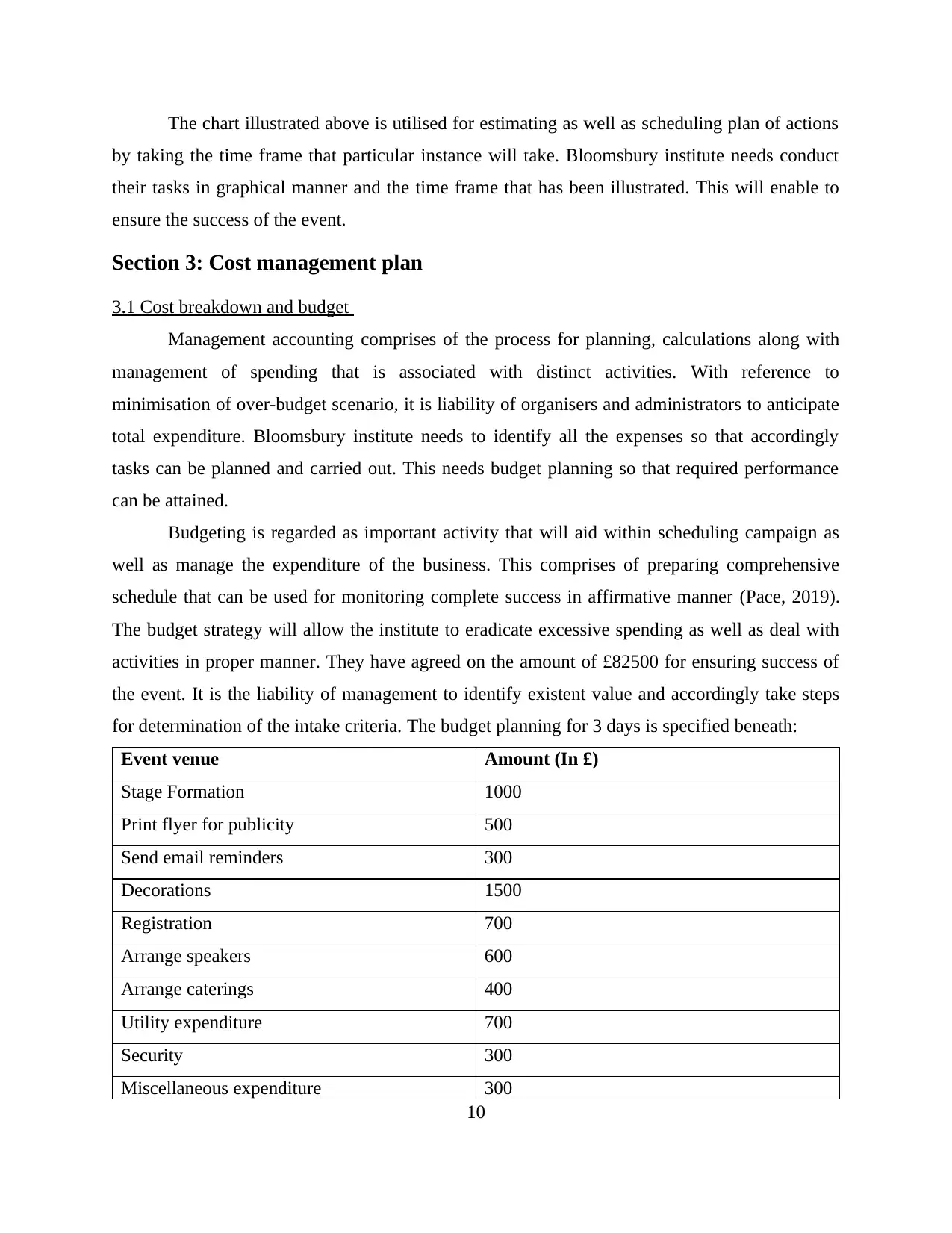
The chart illustrated above is utilised for estimating as well as scheduling plan of actions
by taking the time frame that particular instance will take. Bloomsbury institute needs conduct
their tasks in graphical manner and the time frame that has been illustrated. This will enable to
ensure the success of the event.
Section 3: Cost management plan
3.1 Cost breakdown and budget
Management accounting comprises of the process for planning, calculations along with
management of spending that is associated with distinct activities. With reference to
minimisation of over-budget scenario, it is liability of organisers and administrators to anticipate
total expenditure. Bloomsbury institute needs to identify all the expenses so that accordingly
tasks can be planned and carried out. This needs budget planning so that required performance
can be attained.
Budgeting is regarded as important activity that will aid within scheduling campaign as
well as manage the expenditure of the business. This comprises of preparing comprehensive
schedule that can be used for monitoring complete success in affirmative manner (Pace, 2019).
The budget strategy will allow the institute to eradicate excessive spending as well as deal with
activities in proper manner. They have agreed on the amount of £82500 for ensuring success of
the event. It is the liability of management to identify existent value and accordingly take steps
for determination of the intake criteria. The budget planning for 3 days is specified beneath:
Event venue Amount (In £)
Stage Formation 1000
Print flyer for publicity 500
Send email reminders 300
Decorations 1500
Registration 700
Arrange speakers 600
Arrange caterings 400
Utility expenditure 700
Security 300
Miscellaneous expenditure 300
10
by taking the time frame that particular instance will take. Bloomsbury institute needs conduct
their tasks in graphical manner and the time frame that has been illustrated. This will enable to
ensure the success of the event.
Section 3: Cost management plan
3.1 Cost breakdown and budget
Management accounting comprises of the process for planning, calculations along with
management of spending that is associated with distinct activities. With reference to
minimisation of over-budget scenario, it is liability of organisers and administrators to anticipate
total expenditure. Bloomsbury institute needs to identify all the expenses so that accordingly
tasks can be planned and carried out. This needs budget planning so that required performance
can be attained.
Budgeting is regarded as important activity that will aid within scheduling campaign as
well as manage the expenditure of the business. This comprises of preparing comprehensive
schedule that can be used for monitoring complete success in affirmative manner (Pace, 2019).
The budget strategy will allow the institute to eradicate excessive spending as well as deal with
activities in proper manner. They have agreed on the amount of £82500 for ensuring success of
the event. It is the liability of management to identify existent value and accordingly take steps
for determination of the intake criteria. The budget planning for 3 days is specified beneath:
Event venue Amount (In £)
Stage Formation 1000
Print flyer for publicity 500
Send email reminders 300
Decorations 1500
Registration 700
Arrange speakers 600
Arrange caterings 400
Utility expenditure 700
Security 300
Miscellaneous expenditure 300
10
Secure Best Marks with AI Grader
Need help grading? Try our AI Grader for instant feedback on your assignments.
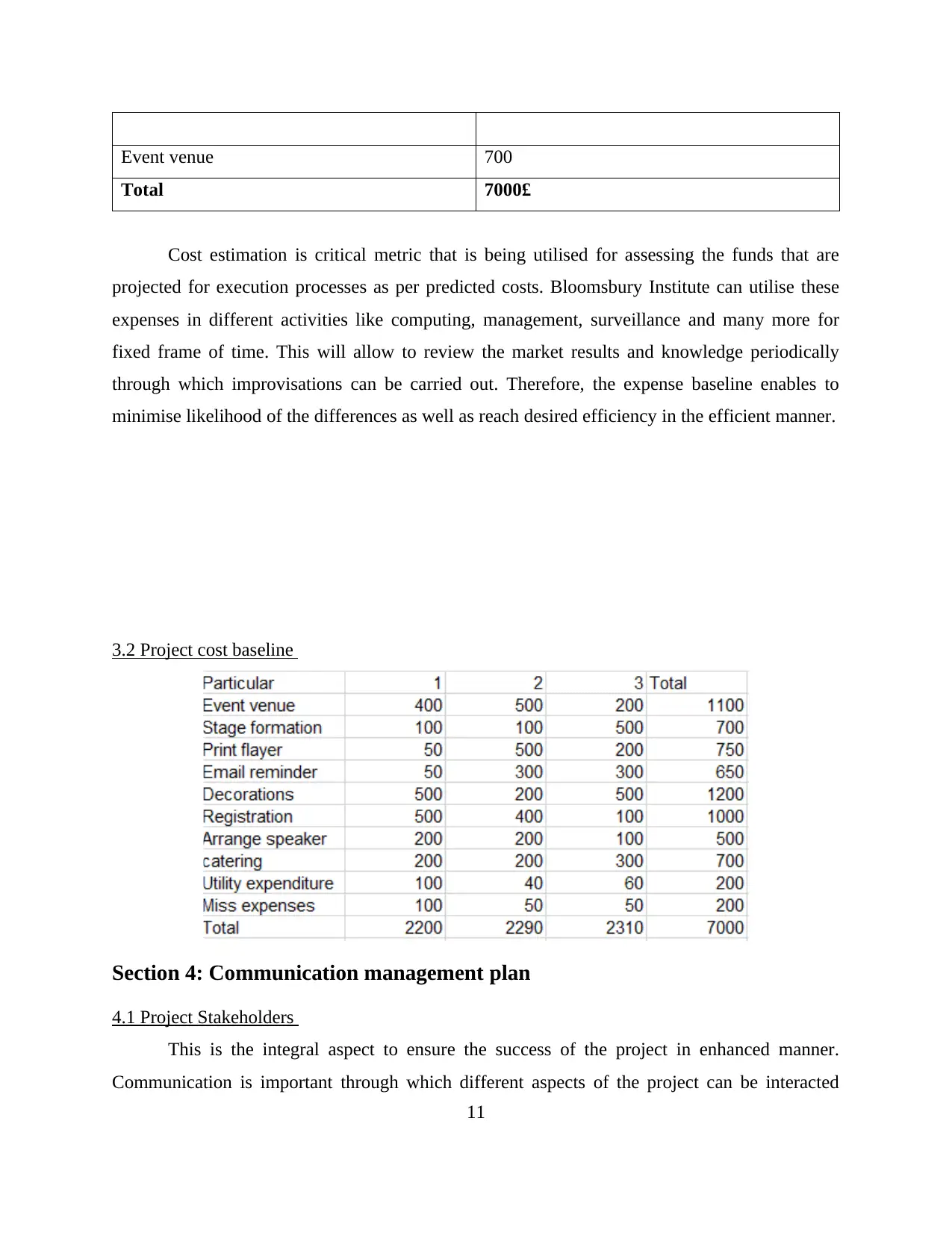
Event venue 700
Total 7000£
Cost estimation is critical metric that is being utilised for assessing the funds that are
projected for execution processes as per predicted costs. Bloomsbury Institute can utilise these
expenses in different activities like computing, management, surveillance and many more for
fixed frame of time. This will allow to review the market results and knowledge periodically
through which improvisations can be carried out. Therefore, the expense baseline enables to
minimise likelihood of the differences as well as reach desired efficiency in the efficient manner.
3.2 Project cost baseline
Section 4: Communication management plan
4.1 Project Stakeholders
This is the integral aspect to ensure the success of the project in enhanced manner.
Communication is important through which different aspects of the project can be interacted
11
Total 7000£
Cost estimation is critical metric that is being utilised for assessing the funds that are
projected for execution processes as per predicted costs. Bloomsbury Institute can utilise these
expenses in different activities like computing, management, surveillance and many more for
fixed frame of time. This will allow to review the market results and knowledge periodically
through which improvisations can be carried out. Therefore, the expense baseline enables to
minimise likelihood of the differences as well as reach desired efficiency in the efficient manner.
3.2 Project cost baseline
Section 4: Communication management plan
4.1 Project Stakeholders
This is the integral aspect to ensure the success of the project in enhanced manner.
Communication is important through which different aspects of the project can be interacted
11
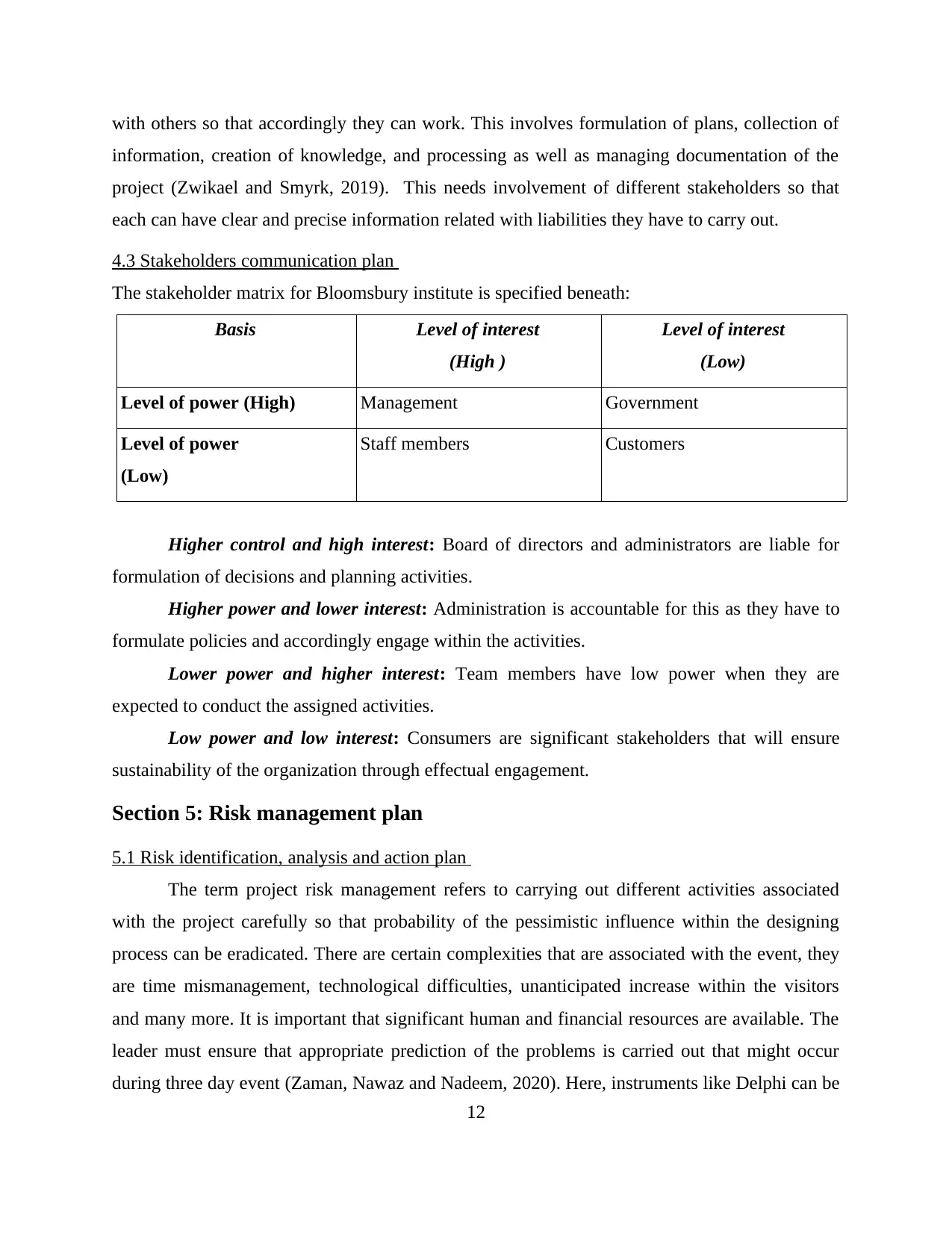
with others so that accordingly they can work. This involves formulation of plans, collection of
information, creation of knowledge, and processing as well as managing documentation of the
project (Zwikael and Smyrk, 2019). This needs involvement of different stakeholders so that
each can have clear and precise information related with liabilities they have to carry out.
4.3 Stakeholders communication plan
The stakeholder matrix for Bloomsbury institute is specified beneath:
Basis Level of interest
(High )
Level of interest
(Low)
Level of power (High) Management Government
Level of power
(Low)
Staff members Customers
Higher control and high interest: Board of directors and administrators are liable for
formulation of decisions and planning activities.
Higher power and lower interest: Administration is accountable for this as they have to
formulate policies and accordingly engage within the activities.
Lower power and higher interest: Team members have low power when they are
expected to conduct the assigned activities.
Low power and low interest: Consumers are significant stakeholders that will ensure
sustainability of the organization through effectual engagement.
Section 5: Risk management plan
5.1 Risk identification, analysis and action plan
The term project risk management refers to carrying out different activities associated
with the project carefully so that probability of the pessimistic influence within the designing
process can be eradicated. There are certain complexities that are associated with the event, they
are time mismanagement, technological difficulties, unanticipated increase within the visitors
and many more. It is important that significant human and financial resources are available. The
leader must ensure that appropriate prediction of the problems is carried out that might occur
during three day event (Zaman, Nawaz and Nadeem, 2020). Here, instruments like Delphi can be
12
information, creation of knowledge, and processing as well as managing documentation of the
project (Zwikael and Smyrk, 2019). This needs involvement of different stakeholders so that
each can have clear and precise information related with liabilities they have to carry out.
4.3 Stakeholders communication plan
The stakeholder matrix for Bloomsbury institute is specified beneath:
Basis Level of interest
(High )
Level of interest
(Low)
Level of power (High) Management Government
Level of power
(Low)
Staff members Customers
Higher control and high interest: Board of directors and administrators are liable for
formulation of decisions and planning activities.
Higher power and lower interest: Administration is accountable for this as they have to
formulate policies and accordingly engage within the activities.
Lower power and higher interest: Team members have low power when they are
expected to conduct the assigned activities.
Low power and low interest: Consumers are significant stakeholders that will ensure
sustainability of the organization through effectual engagement.
Section 5: Risk management plan
5.1 Risk identification, analysis and action plan
The term project risk management refers to carrying out different activities associated
with the project carefully so that probability of the pessimistic influence within the designing
process can be eradicated. There are certain complexities that are associated with the event, they
are time mismanagement, technological difficulties, unanticipated increase within the visitors
and many more. It is important that significant human and financial resources are available. The
leader must ensure that appropriate prediction of the problems is carried out that might occur
during three day event (Zaman, Nawaz and Nadeem, 2020). Here, instruments like Delphi can be
12
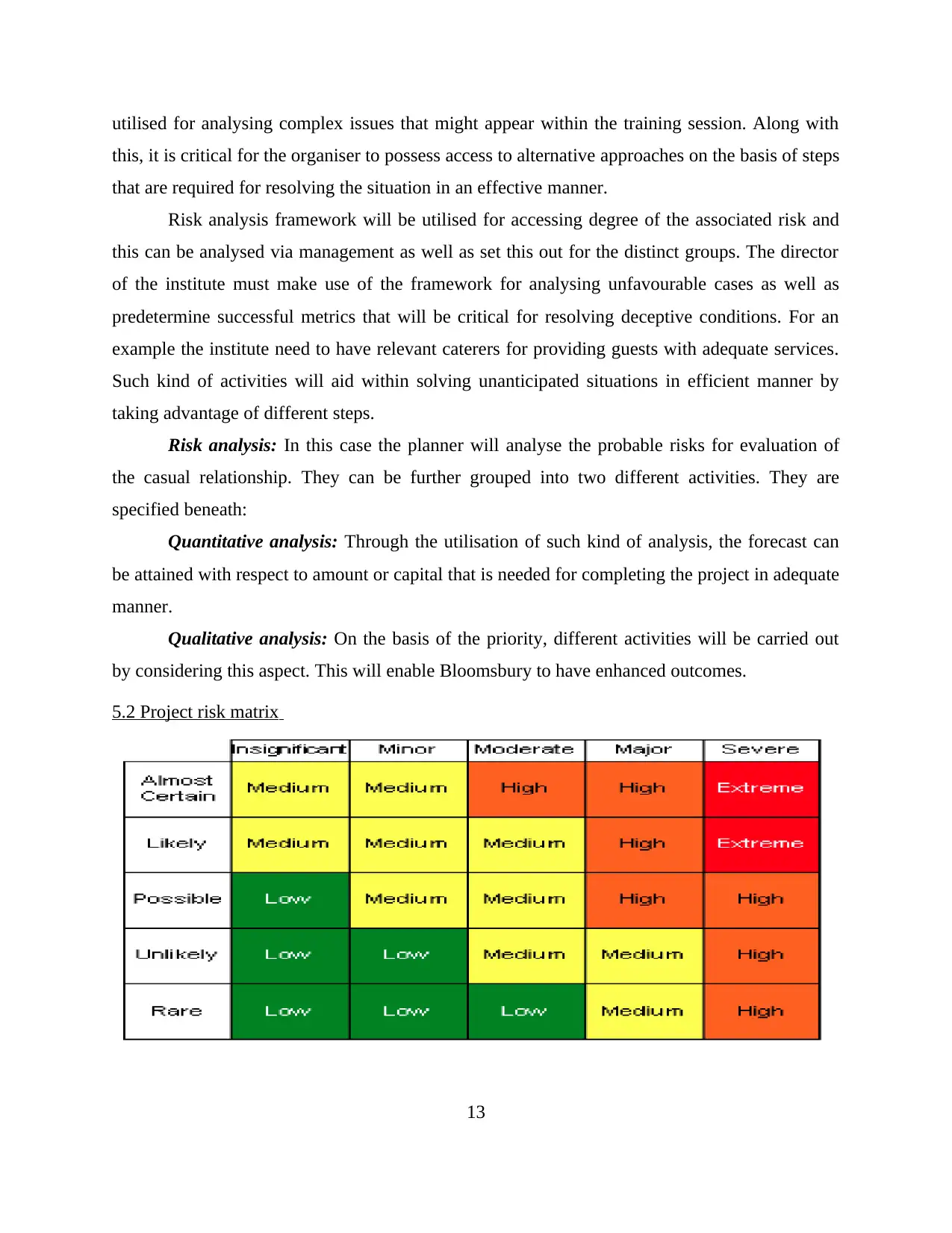
utilised for analysing complex issues that might appear within the training session. Along with
this, it is critical for the organiser to possess access to alternative approaches on the basis of steps
that are required for resolving the situation in an effective manner.
Risk analysis framework will be utilised for accessing degree of the associated risk and
this can be analysed via management as well as set this out for the distinct groups. The director
of the institute must make use of the framework for analysing unfavourable cases as well as
predetermine successful metrics that will be critical for resolving deceptive conditions. For an
example the institute need to have relevant caterers for providing guests with adequate services.
Such kind of activities will aid within solving unanticipated situations in efficient manner by
taking advantage of different steps.
Risk analysis: In this case the planner will analyse the probable risks for evaluation of
the casual relationship. They can be further grouped into two different activities. They are
specified beneath:
Quantitative analysis: Through the utilisation of such kind of analysis, the forecast can
be attained with respect to amount or capital that is needed for completing the project in adequate
manner.
Qualitative analysis: On the basis of the priority, different activities will be carried out
by considering this aspect. This will enable Bloomsbury to have enhanced outcomes.
5.2 Project risk matrix
13
this, it is critical for the organiser to possess access to alternative approaches on the basis of steps
that are required for resolving the situation in an effective manner.
Risk analysis framework will be utilised for accessing degree of the associated risk and
this can be analysed via management as well as set this out for the distinct groups. The director
of the institute must make use of the framework for analysing unfavourable cases as well as
predetermine successful metrics that will be critical for resolving deceptive conditions. For an
example the institute need to have relevant caterers for providing guests with adequate services.
Such kind of activities will aid within solving unanticipated situations in efficient manner by
taking advantage of different steps.
Risk analysis: In this case the planner will analyse the probable risks for evaluation of
the casual relationship. They can be further grouped into two different activities. They are
specified beneath:
Quantitative analysis: Through the utilisation of such kind of analysis, the forecast can
be attained with respect to amount or capital that is needed for completing the project in adequate
manner.
Qualitative analysis: On the basis of the priority, different activities will be carried out
by considering this aspect. This will enable Bloomsbury to have enhanced outcomes.
5.2 Project risk matrix
13
Paraphrase This Document
Need a fresh take? Get an instant paraphrase of this document with our AI Paraphraser
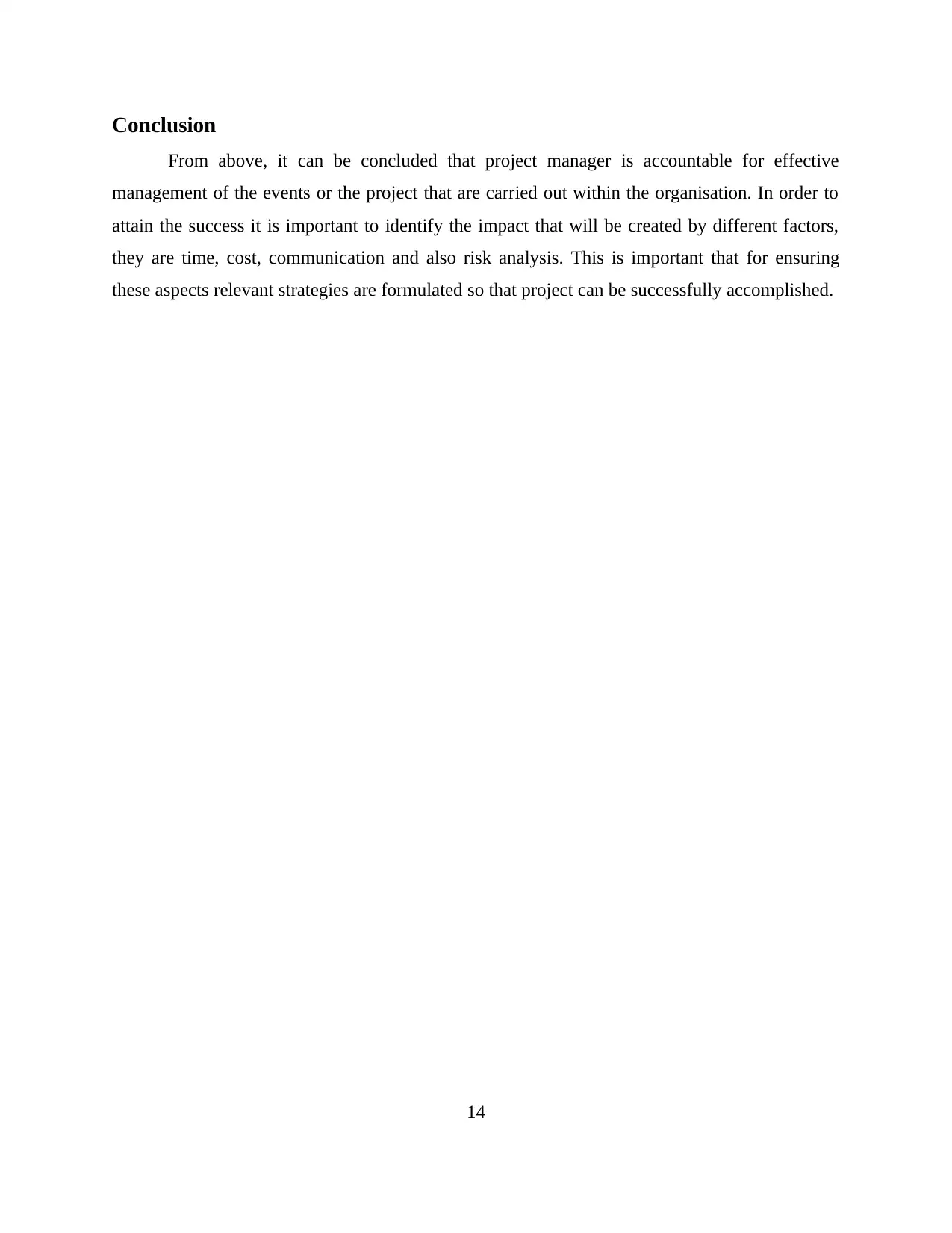
Conclusion
From above, it can be concluded that project manager is accountable for effective
management of the events or the project that are carried out within the organisation. In order to
attain the success it is important to identify the impact that will be created by different factors,
they are time, cost, communication and also risk analysis. This is important that for ensuring
these aspects relevant strategies are formulated so that project can be successfully accomplished.
14
From above, it can be concluded that project manager is accountable for effective
management of the events or the project that are carried out within the organisation. In order to
attain the success it is important to identify the impact that will be created by different factors,
they are time, cost, communication and also risk analysis. This is important that for ensuring
these aspects relevant strategies are formulated so that project can be successfully accomplished.
14
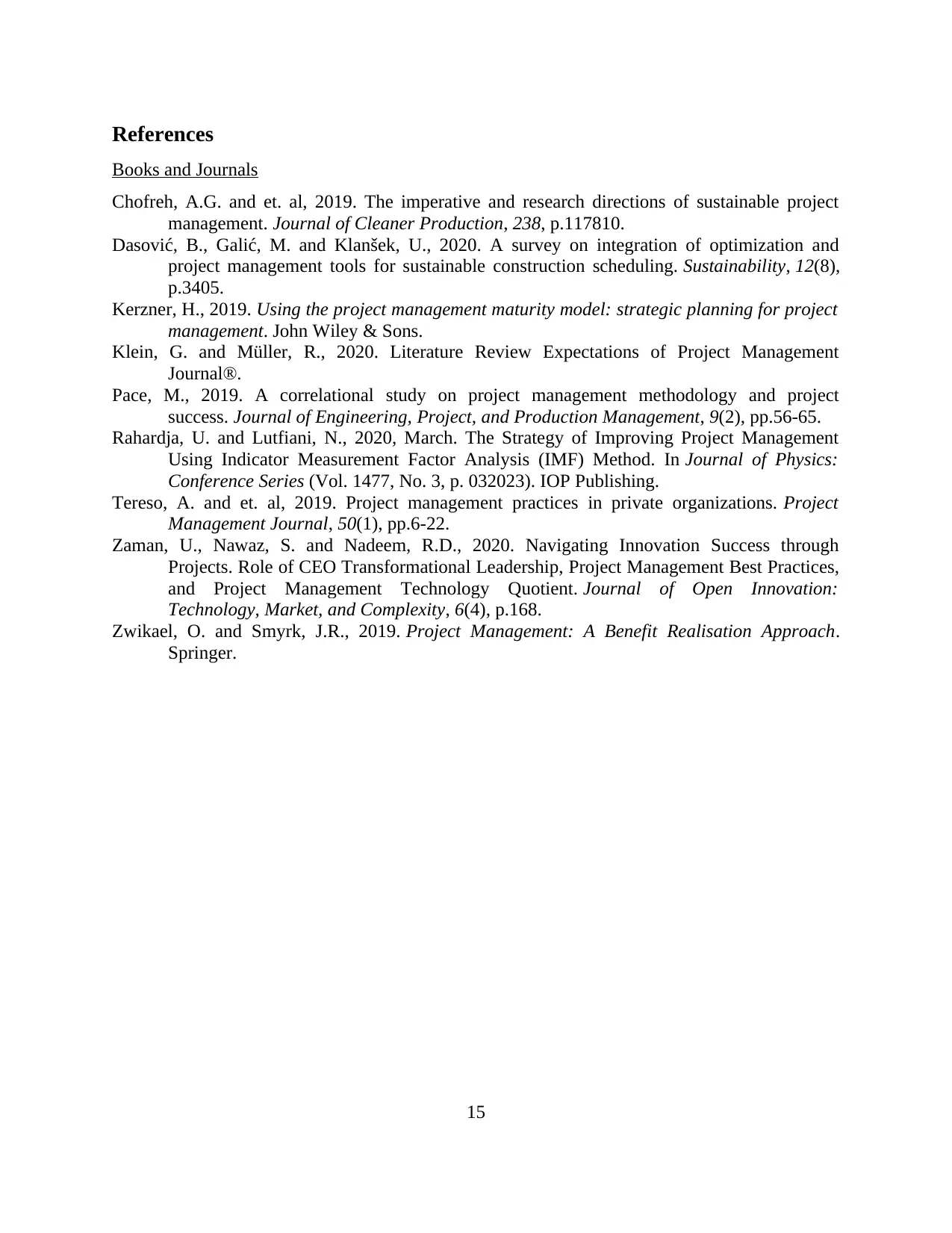
References
Books and Journals
Chofreh, A.G. and et. al, 2019. The imperative and research directions of sustainable project
management. Journal of Cleaner Production, 238, p.117810.
Dasović, B., Galić, M. and Klanšek, U., 2020. A survey on integration of optimization and
project management tools for sustainable construction scheduling. Sustainability, 12(8),
p.3405.
Kerzner, H., 2019. Using the project management maturity model: strategic planning for project
management. John Wiley & Sons.
Klein, G. and Müller, R., 2020. Literature Review Expectations of Project Management
Journal®.
Pace, M., 2019. A correlational study on project management methodology and project
success. Journal of Engineering, Project, and Production Management, 9(2), pp.56-65.
Rahardja, U. and Lutfiani, N., 2020, March. The Strategy of Improving Project Management
Using Indicator Measurement Factor Analysis (IMF) Method. In Journal of Physics:
Conference Series (Vol. 1477, No. 3, p. 032023). IOP Publishing.
Tereso, A. and et. al, 2019. Project management practices in private organizations. Project
Management Journal, 50(1), pp.6-22.
Zaman, U., Nawaz, S. and Nadeem, R.D., 2020. Navigating Innovation Success through
Projects. Role of CEO Transformational Leadership, Project Management Best Practices,
and Project Management Technology Quotient. Journal of Open Innovation:
Technology, Market, and Complexity, 6(4), p.168.
Zwikael, O. and Smyrk, J.R., 2019. Project Management: A Benefit Realisation Approach.
Springer.
15
Books and Journals
Chofreh, A.G. and et. al, 2019. The imperative and research directions of sustainable project
management. Journal of Cleaner Production, 238, p.117810.
Dasović, B., Galić, M. and Klanšek, U., 2020. A survey on integration of optimization and
project management tools for sustainable construction scheduling. Sustainability, 12(8),
p.3405.
Kerzner, H., 2019. Using the project management maturity model: strategic planning for project
management. John Wiley & Sons.
Klein, G. and Müller, R., 2020. Literature Review Expectations of Project Management
Journal®.
Pace, M., 2019. A correlational study on project management methodology and project
success. Journal of Engineering, Project, and Production Management, 9(2), pp.56-65.
Rahardja, U. and Lutfiani, N., 2020, March. The Strategy of Improving Project Management
Using Indicator Measurement Factor Analysis (IMF) Method. In Journal of Physics:
Conference Series (Vol. 1477, No. 3, p. 032023). IOP Publishing.
Tereso, A. and et. al, 2019. Project management practices in private organizations. Project
Management Journal, 50(1), pp.6-22.
Zaman, U., Nawaz, S. and Nadeem, R.D., 2020. Navigating Innovation Success through
Projects. Role of CEO Transformational Leadership, Project Management Best Practices,
and Project Management Technology Quotient. Journal of Open Innovation:
Technology, Market, and Complexity, 6(4), p.168.
Zwikael, O. and Smyrk, J.R., 2019. Project Management: A Benefit Realisation Approach.
Springer.
15
1 out of 15
Related Documents
Your All-in-One AI-Powered Toolkit for Academic Success.
+13062052269
info@desklib.com
Available 24*7 on WhatsApp / Email
![[object Object]](/_next/static/media/star-bottom.7253800d.svg)
Unlock your academic potential
© 2024 | Zucol Services PVT LTD | All rights reserved.





